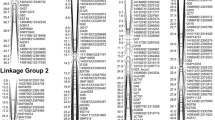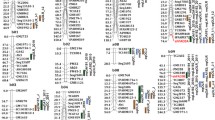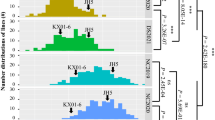Abstract
Oil content and oil quality fractions (viz., oleic, linoleic and linolenic acid) are strongly influenced by the erucic acid pathway in oilseed Brassicas. Low levels of erucic acid in seed oil increases oleic acid content to nutritionally desirable levels, but also increases the linoleic and linolenic acid fractions and reduces oil content in Indian mustard (Brassica juncea). Analysis of phenotypic variability for oil quality fractions among a high-erucic Indian variety (Varuna), a low-erucic east-European variety (Heera) and a zero-erucic Indian variety (ZE-Varuna) developed by backcross breeding in this study indicated that lower levels of linoleic and linolenic acid in Varuna are due to substrate limitation caused by an active erucic acid pathway and not due to weaker alleles or enzyme limitation. To identify compensatory loci that could be used to increase oil content and maintain desirable levels of oil quality fractions under zero-erucic conditions, we performed Quantitative Trait Loci (QTL) mapping for the above traits on two independent F1 doubled haploid (F1DH) mapping populations developed from a cross between Varuna and Heera. One of the populations comprised plants segregating for erucic acid content (SE) and was used earlier for construction of a linkage map and QTL mapping of several yield-influencing traits in B. juncea. The second population consisted of zero-erucic acid individuals (ZE) for which, an Amplified Fragment Length Polymorphism (AFLP)-based framework linkage map was constructed in the present study. By QTL mapping for oil quality fractions and oil content in the ZE population, we detected novel loci contributing to the above traits. These loci did not co-localize with mapped locations of the fatty acid desaturase 2 (FAD2), fatty acid desaturase 3 (FAD3) or fatty acid elongase (FAE) genes unlike those of the SE population wherein major QTL were found to coincide with mapped locations of the FAE genes. Some of the new loci identified in the ZE population could be detected as ‘weak’ contributors (with LOD < 2.5) in the SE population in which their contribution to the traits was “masked” due to pleiotropic effects of erucic acid genes. The novel loci identified in this study could now be used to improve oil quality parameters and oil content in B. juncea under zero-erucic conditions.






Similar content being viewed by others
References
Barker GC, Larson TR, Graham IA, Lynn JR, King GJ (2007) Novel insights into seed fatty acid synthesis and modification pathways from genetic diversity and quantitative trait Loci analysis of the Brassica C genome. Plant Physiol 144:1827–1842
Boulter GS (1983) The history and marketing of rapeseed oil in Canada. In: Kramer JKG, Sauer FD, Pigden WJ (eds) High and low erucic acid in rapeseed oils production, usage, chemistry and toxicological evaluation. Academic Press, Canada
Browse J, Spychalla J, Okuley J, Lightner J (1998) Altering the fatty acid composition of vegetable oils. In: Harwood JL (ed) Plant lipid biosynthesis: fundamentals and agricultural applications. Cambridge University Press, UK, pp 131–153
Burns MJ, Barnes SR, Bowman JG, Clarke MHE, Werner CP, Kearsey MJ (2003) QTL analysis of an intervarietal set of substitution lines in Brassica napus: seed oil content and fatty acid composition. Heredity 90:39–48
Chang NW, Huang PC (1998) Effects of the ratio of polyunsaturated and monounsaturated fatty acids on rat plasma and liver lipid concentration. Lipids 33:481–487
Chen JL, Beversdorf WD (1990) A comparison of traditional and haploid-derived breeding populations of oilseed rape (Brassica napus L.) for fatty acid composition of the seed oil. Euphytica 51:59–65
Cheung WY, Landry BS, Raney P, Rakow GFW (1998) Molecular mapping of seed quality traits in Brassica juncea L. Czern. and Coss. Acta Hort 459:139–147
Churchill GA, Doerge RW (1994) Emperical threshold values for quantitative trait mapping. Genetics 138:963–971
Delourme R, Falentin C, Huteau V, Clouet V, Horvais R, Gandon B, Specel S, Hanneton L, Dheu JE, Deschamps M, Margale E, Vincout P, Renard M (2006) Genetic control of oil content in oilseed rape (Brassica napus L.). Theor Appl Genet 113:1331–1345
Doerge RW, Churchill GA (1996) Permutation test for multiple loci affecting a quantitative character. Genetics 142:285–294
Ecke W, Uzunova M, Weissleder K (1995) Mapping the genome of rapeseed (Brassica napus L.) II. Localization of genes controlling erucic acid synthesis and seed oil content. Theor Appl Genet 91:972–977
Gupta V, Mukhopadhyay A, Arumugam N, Sodhi YS, Pental D, Pradhan AK (2004) Molecular tagging of erucic acid trait in oilseed mustard (Brassica juncea) by QTL mapping and single nucleotide polymorphisms in FAE1 gene. Theor Appl Genet 108:743–749
Horiguchi G, Kodama H, Iba K (2001) Characterization of Arabidopsis mutants that are associated with altered C18 unsaturated fatty acid metabolism. Plant Science 161:1117–1123
Lauridsen C, Hojsgaard S, Sorensen MT (1999) Influence of dietary rapeseed oil, vitamin E, and copper on the performance and the antioxidative and oxidative status of pigs. J Anim Sci 77:906–916
Li R-J, Wang H-Z, Mao H, Lu Y-T, Hua W (2006) Identification of differentially expressed genes in seeds of two near-isogenic Brassica napus lines with different oil content. Planta 224:952–962
Lionneton E, Ravera S, Sanchez L, Aubert G, Delourme R, Ochatt S (2002) Development of an AFLP-based linkage map and localization of QTLs for seed fatty acid content in condiment mustard (Brassica juncea). Genome 45:1203–1215
Mika V, Tillmann P, Kopma R, Nerusil P, Kucera V (2003) Fast prediction of quality parameters in whole seeds of oilseed rape (Brassica napus L.). Plant Soil Environ 49:141–145
Mukhopadhyay A, Arumugam N, Sodhi YS, Gupta V, Pradhan AK, Pental D (2007) High frequency production of microspore derived doubled haploid (DH) and its application for developing low glucosinolate lines in Indian Brassica juncea. In: 12th International rapeseed congress, Wuhan, China. pp 333–335
Panjabi P, Jagannath A, Bisht NC, Padmaja KL, Sharma S, Gupta V, Pradhan AK, Pental D (2008) Comparative mapping of Brassica juncea and Arabidopsis thaliana using Intron Polymorphism (IP) markers: homoeologous relationships, diversification and evolution of the A, B and C Brassica genomes. BMC Genom 9:113
Pradhan AK, Gupta V, Mukhopadhyay A, Arumugam N, Sodhi YS, Pental D (2003) A high-density linkage map in Brassica juncea (Indian mustard) using AFLP and RFLP markers. Theor Appl Genet 106:607–614
Ramchiary N, Padmaja KL, Sharma S, Gupta V, Sodhi YS, Mukhopadhyay A, Arumugam N, Pental D, Pradhan AK (2007) Mapping of yield influencing QTL in Brassica juncea: implications for breeding of a major oilseed crop of dryland areas. Theor Appl Genet 115:807–817
Rogers SO, Bendich AJ (1994) Extraction of total cellular DNA from plants, algae and fungi. In: Gelvin SV, Shilperoot RA (eds) Plant molecular biology manual. Kluwer, Dordrecht, pp 1–8
Sharma R, Aggarwal RA, Kumar R, Mohapatra T, Sharma RP (2002) Construction of an RAPD linkage map and localization of QTLs for oleic acid level using recombinant inbreds in mustard (Brassica juncea). Genome 45:467–472
Stam P (1993) Construction of integrated genetic linkage maps by means of a new computer package: JoinMap. Plant J 3:739–744
Stam P, Van Ooijen J (1996) Joinmap version 2.0: software for the calculation of genetic linkage maps. CPRO-DLO, Wageningen
Tanhuanpää PK, Vilkki JP, Vilkki HJ (1996) Mapping of a QTL for oleic acid concentration in spring turnip rape (Brassica rapa ssp. oleifera). Theor Appl Genet 92:952–956
Tanhuanpää P, Vilkki J, Vihinen M (1998) Mapping and cloning of FAD2 gene to develop allele-specific PCR for oleic acid in spring turnip rape Brassica rapa spp. oleifera. Mol Breed 4:543–550
Tanhuanpää P, Schulman A (2002) Mapping of genes affecting linolenic acid content in Brassica rapa ssp. oleifera. Mol Breed 10:51–62
Thies W (1971) Schnelle und einfache Analysen der Fettsaurzusam-mensetzung in einzelnen Raps-Kotyledonen I. Gaschromatographische and papier-chromatographische Methoden. Z Pflanzenzuchtg 65:181–202
Wang S, Basten CJ, GaVney P, Zeng ZB (2001–2005) Windows QTL Cartographer version 2.5. North Carolina State University, Bioinformatics Research Center, Raleigh
Zeng ZB (1993) Theoretical basis for separation of multiple linked gene effects in mapping quantitative trait loci. Proc Natl Acad Sci USA 90:10972–10976
Zeng ZB (1994) Precision mapping of quantitative trait loci. Genetics 136:1457–1468
Zhao JC, Becker HC, Zhang D, Zhang Y, Ecke W (2006) Conditional QTL mapping of oil content in rapeseed with respect to protein content and traits related to plant development and grain yield. Theor Appl Genet 113:33–38
Acknowledgments
This work was supported by the Mother Dairy Fruit & Vegetable Private Limited (MDFVPL), a subsidiary of the National Dairy Development Board (NDDB), India. The authors gratefully acknowledge the assistance of Mr. Satish Kumar Yadav in editing the Figures.
Author information
Authors and Affiliations
Corresponding author
Additional information
Communicated by C. Quiros.
Electronic supplementary material
Below is the link to the electronic supplementary material.
Rights and permissions
About this article
Cite this article
Jagannath, A., Sodhi, Y.S., Gupta, V. et al. Eliminating expression of erucic acid-encoding loci allows the identification of “hidden” QTL contributing to oil quality fractions and oil content in Brassica juncea (Indian mustard). Theor Appl Genet 122, 1091–1103 (2011). https://doi.org/10.1007/s00122-010-1515-2
Received:
Accepted:
Published:
Issue Date:
DOI: https://doi.org/10.1007/s00122-010-1515-2




